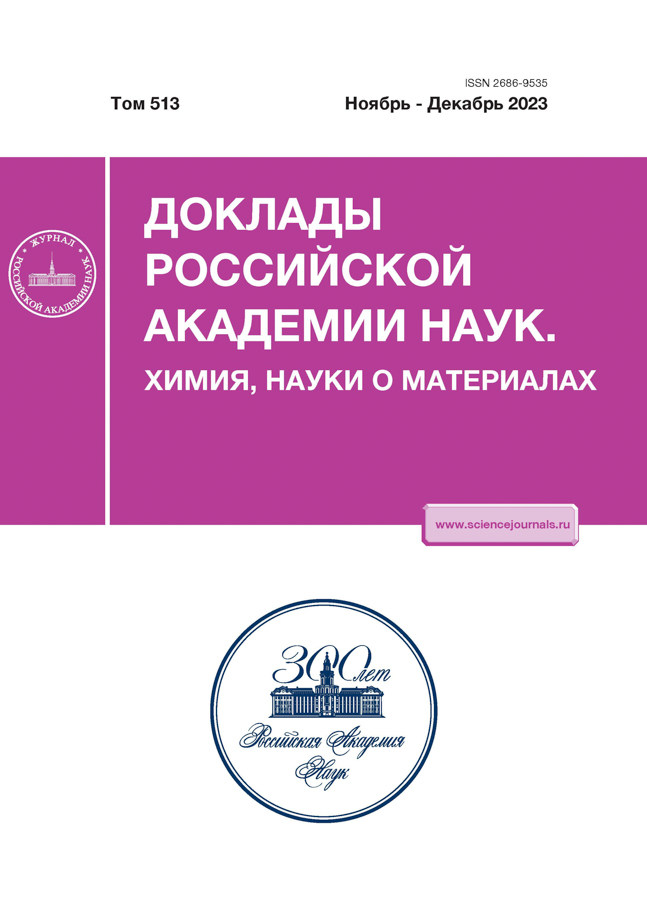PHASE FORMATION IN ALKALINE TITANOSILICATE SYSTEMS DURING HYDROTHERMAL SYNTHESIS
- Autores: Gerasimova L.G.1, Shchukina E.S.1, Maslova M.V.1, Nikolaev A.I.1
-
Afiliações:
- Tananaev Institute of Chemistry – Subdivision of the Federal Research Centre “Kola Science Centre of the Russian Academy of Sciences”, Science Centre of Russian Academy of Sciences
- Edição: Volume 513, Nº 1 (2023)
- Páginas: 86-92
- Seção: CHEMISTRY
- URL: https://snv63.ru/2686-9535/article/view/651936
- DOI: https://doi.org/10.31857/S2686953523700255
- EDN: https://elibrary.ru/BIUMSJ
- ID: 651936
Citar
Texto integral
Resumo
The investigations in the polycomponent high alkaline systems – TiO2–H2SO4–Na2SiO3–NaOH–H2O and TiO2–H2SO4–(NH4)2SO4–Na2SiO3–NaOH–H2O under hydrothermal synthesis conditions have been carried out to provide new products with the given technical properties. It has been shown that by directed selection of structure-forming components, in particular titanium compounds, together with optimal parameters of hydrothermal treatment of the obtained precursor, it is possible to form compounds with the given phase and chemical composition, morphology and particle size. It was found that the rate of structural transformations during synthesis depends on the phase composition of titanosilicate precursors. During their hydrothermal treatment, alkaline and thermal hydrolysis with subsequent dehydration of hydrolyzed phases of titanium (IV) and silicon take place. The process is accompanied by localization of free bonds providing formation of Ti–O–Si–O-bridges and their subsequent transformation into structured new formations.
Sobre autores
L. Gerasimova
Tananaev Institute of Chemistry – Subdivision of the Federal Research Centre “Kola Science Centre of the Russian Academy of Sciences”, Science Centre of Russian Academy of Sciences
Autor responsável pela correspondência
Email: l.gerasimova@ksc.ru
Russian Federation, 184209, Murmansk region, Apatity
E. Shchukina
Tananaev Institute of Chemistry – Subdivision of the Federal Research Centre “Kola Science Centre of the Russian Academy of Sciences”, Science Centre of Russian Academy of Sciences
Email: l.gerasimova@ksc.ru
Russian Federation, 184209, Murmansk region, Apatity
M. Maslova
Tananaev Institute of Chemistry – Subdivision of the Federal Research Centre “Kola Science Centre of the Russian Academy of Sciences”, Science Centre of Russian Academy of Sciences
Email: l.gerasimova@ksc.ru
Russian Federation, 184209, Murmansk region, Apatity
A. Nikolaev
Tananaev Institute of Chemistry – Subdivision of the Federal Research Centre “Kola Science Centre of the Russian Academy of Sciences”, Science Centre of Russian Academy of Sciences
Email: l.gerasimova@ksc.ru
Russian Federation, 184209, Murmansk region, Apatity
Bibliografia
- Yakovenchuk V.N., Krivovichev S.V., Pakhomovsky Y.A., Selivanova E.A., Ivanyuk G.Y. Microporous titanosilicates of the lintisite-kukisvumite group and their transformation in acidic solutions. In: Minerals as advanced materials II. Krivovichev S.V. (Ed.). Springer, Berlin, Heidelberg, 2012. P. 229–238. https://doi.org/10.1007/978-3-642-20018-2_23
- Folli A., Pochard I., Nonat A., Jakobsen U.H., She-pherd A.M., Macphee D.E. // J. Am. Ceram. Soc. 2010. V. 93 (10). P. 3360–3369. https://doi.org/10.1111/j.1551-2916.2010.03838.x
- Young D.A. Crystalline titano-silicate zeolites. Patent US3329481A. 1967.
- Taramasso M., Perego G., Notari B. Preparation of porous crystalline synthetic material comprised of silicon and titanium oxides. Patent US4410501A. 1983.
- Kuznicki S.M. Large-pored crystalline titanium mole-cular sieve zeolites. Patent US5011591A. 1991.
- Ferraris G., Khomyakov A.P., Belluso E., Soboleva S. Polysomatic relationships in some titanosilicates occurring in the hyperagpaitic alkaline rocks of the Kola Peninsula, Russia. In: Mineralogy. Proc. 30th Int. Geol. Cong., V. 16. Huang Yunhui, Cao Yawen (Ed.). London: CRC Press. 1998. P. 17–27. https://doi.org/10.1201/9781003079569
- Liu L., Tan W., Xiao P., Zhai Y. // Int. J. Miner. Metall. Mater. 2012. V. 19. P. 675–678. https://doi.org/10.1007/s12613-012-0612-4
- Xu H., Zhang Y., Navrotsky A. // Micropor. Mesopor. Mat. 2001. V. 47. P. 285–291. https://doi.org/10.1016/S1387-1811(01)00388-2
- Mann N.R., Todd T.A. // Sep. Sci. Technol. 2005. V. 39. № 10. P. 2351–2371. https://doi.org/10.1081/SS-120039321
- Спиридонова Д.В., Кривовичев С.В., Яковенчук В.Н., Пахомовский Я.А. // ЗРМО. 2010. № 5. С. 79–88.
- Gerasimova L.G., Nikolaev A.I., Shchukina E.S., Mas-lova M.V. // Dokl. Chem. 2020. V. 491. № 1. C. 49–53. https://doi.org/10.1134/S0012500820030039
- Щукина Е.С., Герасимова Л.Г., Маслова М.В. // Фундаментальные исследования. 2018. № 11–1. С. 18–23. https://doi.org/10.17513/fr.42294
- Wei M., Zhang L., Xiong Y., Li J., Peng P. // Microporous Mesoporous Mater. 2016. V. 227. P. 88–94. https://doi.org/10.1016/j.micromeso.2016.02.050
- De Boer J.H., Lippens B.C., Linsen B.G., Broekhoff J.C.P., van den Heuvel A., Osinga Th.J. // J. Colloid Interface Sci. 1966. V. 21. № 4. P. 405–414. https://doi.org/10.1016/0095-8522(66)90006-7
- Neimark A.V., Ravikovitch P.I., Vishnyakov A. // J. Phys. Condens. Matter. 2003. V. 15. № 3. P. 347–367. https://doi.org/10.1088/0953-8984/15/3/303
- Samburov G.O., Kalashnikova G.O., Panikorovskii T.L., Bocharov V.N., Kasikov A., Selivanova E., Bazai A.V., Bernadskaya D., Yakovenchuk V.N., Krivovichev S.V. // Crystals. 2022. V. 12. № 3. P. 311. https://doi.org/10.3390/cryst12030311
- Perovskiy I., Yanicheva N.Yu., Stalyugin V.V., Paniko-rovskii T.L., Golov A.A. // Microporous Mesoporous Mater. 2021. V. 311. P. 110716. https://doi.org/10.1016/j.micromeso.2020.110716
Arquivos suplementares
















